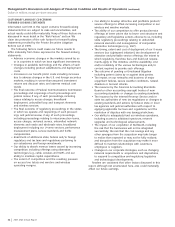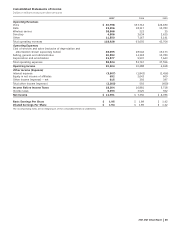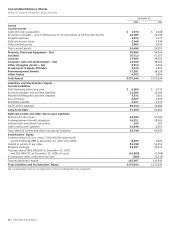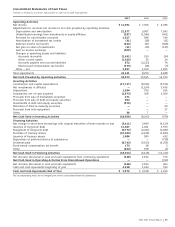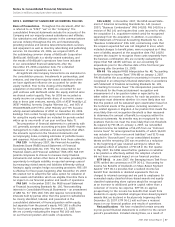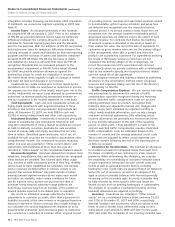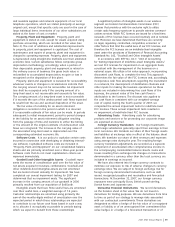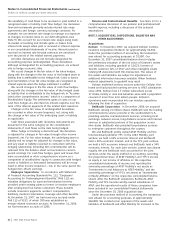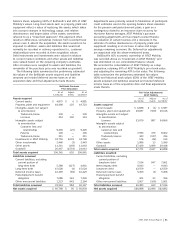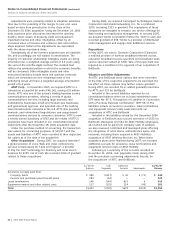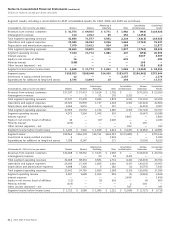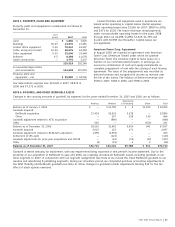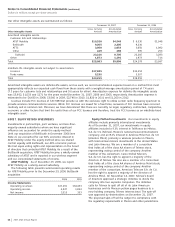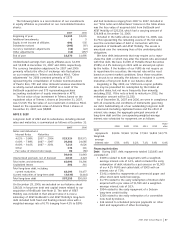AT&T Wireless 2007 Annual Report Download - page 62
Download and view the complete annual report
Please find page 62 of the 2007 AT&T Wireless annual report below. You can navigate through the pages in the report by either clicking on the pages listed below, or by using the keyword search tool below to find specific information within the annual report.
Notes to Consolidated Financial Statements (continued)
Dollars in millions except per share amounts
60
| 2007 AT&T Annual Report
the variability of cash flows to be received or paid related to a
recognized asset or liability (cash flow hedge). Our derivative
financial instruments primarily include interest rate swap
agreements and foreign currency exchange contracts. For
example, we use interest rate swaps to manage our exposure
to changes in interest rates on our debt obligations (see
Note 9). We account for our interest rate swaps using mark-
to-market accounting and include gains or losses from
interest rate swaps when paid or received in interest expense
in our consolidated statements of income. Amounts paid or
received on interest rate forward contracts are amortized
over the period of the related interest payments.
All other derivatives are not formally designated for
accounting purposes (undesignated). These derivatives,
although undesignated for accounting purposes, are entered
into to hedge economic risks.
We record changes in the fair value of fair value hedges,
along with the changes in the fair value of the hedged asset or
liability that is attributable to the hedged risk. Gains or losses
upon termination of our fair value hedges are recognized as
interest expense when the hedge instrument is settled.
We record changes in the fair value of cash flow hedges,
along with the changes in the fair value of the hedged asset
or liability that is attributable to the hedged risk, in “Accumu-
lated other comprehensive income,” which is a component of
Stockholders’ Equity. The settlement gains or costs on our
cash flow hedges are amortized as interest expense over the
term of the interest payments of the related debt issuances.
Changes in the fair value of undesignated derivatives
are recorded in other income (expense), net, along with
the change in fair value of the underlying asset or liability,
as applicable.
Cash flows associated with derivative instruments are
presented in the same category on the consolidated
statements of cash flows as the item being hedged.
When hedge accounting is discontinued, the derivative
is adjusted for changes in fair value through other income
(expense), net. For fair value hedges, the underlying asset or
liability will no longer be adjusted for changes in fair value,
and any asset or liability recorded in connection with the
hedging relationship (including firm commitments) will be
removed from the balance sheet and recorded in current-
period earnings. For cash flow hedges, gains and losses that
were accumulated in other comprehensive income as a
component of stockholders’ equity in connection with hedged
assets or liabilities or forecasted transactions will be recog-
nized in other income (expense) – net, in the same period the
hedged item affects earnings.
Employee Separations In accordance with Statement
of Financial Accounting Standards No. 112, “Employers’
Accounting for Postemployment Benefits,” (FAS 112) we
establish obligations for expected termination benefits
provided under existing plans to former or inactive employees
after employment but before retirement. These benefits
include severance payments, workers’ compensation,
disability, medical continuation coverage and other benefits.
At December 31, 2007, we had severance accruals under
FAS 112 of $153, of which $99 was established as
merger-related severance accruals. At December 31, 2006,
we had severance accruals of $286.
Pension and Postretirement Benefits See Note 11 for a
comprehensive discussion of our pension and postretirement
benefit expense, including a discussion of the actuarial
assumptions.
NOTE 2. ACQUISITIONS, DISPOSITIONS, VALUATION AND
OTHER ADJUSTMENTS
Acquisitions
Dobson In November 2007, we acquired Dobson Commu-
nications Corporation (Dobson) for approximately $2,500.
Under the purchase method of accounting, the transaction
was valued, for accounting purposes, at $2,580. Our
December 31, 2007 consolidated balance sheet includes
the preliminary valuation of the fair value of Dobson’s assets
and liabilities, including goodwill of $2,623, licenses of
$2,230, customer lists of $517 and other intangible assets
totaling $8 associated with this transaction. The values of
the assets and liabilities are subject to adjustment as
additional information becomes available. When finalized,
material adjustments to goodwill may result.
Dobson marketed wireless services under the Cellular One
brand and had provided roaming services to AT&T subsidiaries
since 1990. Dobson had 1.7 million subscribers across
17 states, mostly in rural and suburban areas with a population
covered of more than 12.6 million people. Dobson’s
operations were incorporated into our wireless operations
following the date of acquisition.
BellSouth Corporation In December 2006, we acquired
BellSouth, issuing 2.4 billion shares. BellSouth was the leading
communications service provider in the southeastern U.S.,
providing wireline communications services, including local
exchange, network access, long-distance services and Internet
services to substantial portions of the population across
nine states. BellSouth also provided long-distance services
to enterprise customers throughout the country.
We and BellSouth jointly owned AT&T Mobility and the
Internet-based publisher YPC. In the AT&T Mobility joint
venture, we held a 60% economic interest and BellSouth
held a 40% economic interest, and in the YPC joint venture,
we held a 66% economic interest and BellSouth held a 34%
economic interest. For each joint venture, control was shared
equally. We and BellSouth each accounted for the joint
ventures under the equity method of accounting, recording
the proportional share of AT&T Mobility’s and YPC’s income
as equity in net income of affiliates on the respective
consolidated statements of income and reporting the
ownership percentage of AT&T Mobility’s net assets as
“Investments in and Advances to AT&T Mobility” and the
ownership percentage of YPC’s net assets as “Investments
in Equity Affiliates” on the respective consolidated balance
sheets. After the BellSouth acquisition, BellSouth, AT&T
Mobility and YPC became wholly-owned subsidiaries of
AT&T, and the operational results of these companies have
been included in our consolidated financial statements
since the December 29, 2006 acquisition date.
Under the purchase method of accounting, the transaction
was valued, for accounting purposes, at approximately
$66,800. We conducted an appraisal of the assets and
liabilities of BellSouth and AT&T Mobility for inclusion in the




